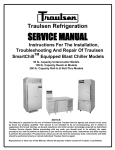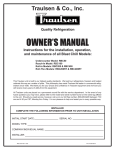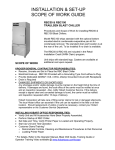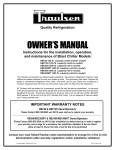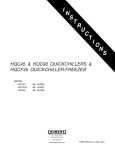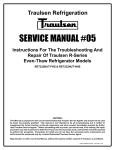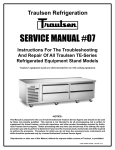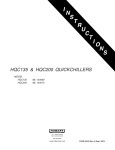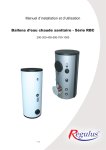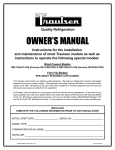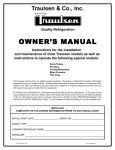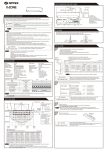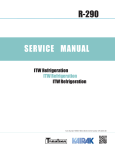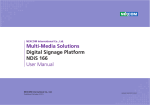Download SERVICE MANUAL #03
Transcript
Traulsen Refrigeration SERVICE MANUAL #03 Instructions for the Installation, Troubleshooting and Repair of Traulsen SmartChill® Equipped Blast Chiller Models 50 lb. Capacity Under counter Models 100 lb. Capacity Reach-In Models 200 lb. Capacity Roll-In & Roll-Thru Models -NOTICEThis Manual is prepared for the use of trained Authorized Traulsen Service Agents and should not be used by those not properly qualified. This manual is not intended to be all encompassing, but is written to supplement the formal training, on-the-job experience and other product knowledge acquired by Authorized Traulsen Service Agents. Before proceeding with any work, you should read, in its entirety, the repair procedure you wish to perform to determine if you have the necessary tools, instruments and skills required to perform the procedure. Only a trained Authorized Traulsen Service Agent should perform procedures for which you do not have the necessary tools, instruments and skills. Reproduction or other use of this Manual, without the express written consent of Traulsen, is prohibited. 375-60240-00 I. TABLE OF CONTENTS Page I. TABLE OF CONTENTS ....................................................................................................... 1 II. GENERAL INFORMATION .............................................................................................. II.a. INTRODUCTION .................................................................................................... II.b. OPERATION ........................................................................................................... II.c. CLEANING.............................................................................................................. II.d. APPLICABLE MODELS ........................................................................................ II.e. WIRING DIAGRAMS ............................................................................................. II.f. TOOL REQUIREMENTS ........................................................................................ II.g. THE SERIAL TAG .................................................................................................. 3 3 3 3 3 3 4 4 III. SPECIFICATIONS/OPERATIONS DATA ..................................................................... III.a. PRODUCT SPECIFICATIONS ............................................................................. III.b. OPERATING DATA .............................................................................................. III.c. REFRIGERATION SYSTEM INSTALLATION .................................................. 5 5 5 5 IV. SERVICING THE SmartChill® CONTROL................................................................... 6 IV.a. SERVICE MODE ................................................................................................... 6 IV.b. UPDATING THE SERVICE DATE ...................................................................... 6 IV.c. SETTING THE CLOCK......................................................................................... 6 IV.d. SERVICE MENU ................................................................................................... 6 IV.e. SERVICE MENU-DIAGNOSTIC TEST ............................................................... 7 IV.f. SERVICE MENU-REF’N SYSTEM AND AIR PROBE TEST ............................ 7 IV.g. SERVICE MENU-PROBES/ALARM TEST......................................................... 8 IV.h. SERVICE MENU-DISPLAY TEST ...................................................................... 8 IV.i. SERVICE MENU-DEFROST SYSTEM & COIL PROBE TEST ......................... 9 IV.j. SERVICE MENU-FAN OUTPUT TEST ............................................................... 9 IV.k. SERVICE MENU-PRINTER TEST ...................................................................... 10 V. SmartChill® FACTORY SETTINGS ................................................................................. V.a. FACTORY SETTINGS MODE............................................................................... V.b. RESETTING THE SERIAL NUMBER .................................................................. V.c. SETTINGS-LABEL PRINTER ............................................................................... V.d. SETTINGS-BLASTING DIFF ................................................................................ V.e. SETTINGS-HOLDING DIFF .................................................................................. V.f. SETTINGS-ANTI-SHORT ...................................................................................... V.g. SETTINGS-DEFROST TIME ................................................................................. V.h. SETTINGS-DEFROST TEMP ................................................................................ V.i. SETTINGS-DEFROST INTVL................................................................................ V.j. SETTINGS-SECURITY CODE ............................................................................... V.k. SECURE SETTINGS-MACH.MODEL .................................................................. V.l. SECURE SETTINGS-MACHINE SIZE .................................................................. V.m. SECURE SETTINGS-DEFROST TYPE ............................................................... V.n. SECURE SETTINGS-SAVING CHANGES .......................................................... 54 – REV. 04/06 1 10 10 10 11 11 11 11 12 12 12 12 13 13 14 14 Table of Contents - Continued Page V.i. SETTINGS-DEFROST INTVL......................................................................................... 15 VI.a. CONTROLLER BOARD........................................................................................ 15 VI.b. RELAY BOARD..................................................................................................... 16 VII. COMPONENT FUNCTION ............................................................................................. 17 VIII. SEQUENCE OF OPERATION ...................................................................................... VIII.a. REFRIGERATION SYSTEM - HOLD MODE................................................... VIII.b. REMOTE REFRIGERATION SYSTEM (RBC200 only)................................... VIII.c. IDLE MODE......................................................................................................... VIII.d. HOLD MODE ...................................................................................................... VIII.e. BY TIME CHILL OR FREEZE MODE .............................................................. VIII.f. BY TEMP CHILL OR FREEZE MODE .............................................................. VIII.g. BY PRODUCT CHILL OR FREEZE MODE ..................................................... VIII.h. DEFROST MODE................................................................................................ 18 18 18 18 18 19 19 20 20 IX. SERVICE PROCUDURE ................................................................................................... IX.a. TEMPERATURE AIR SENSORS.......................................................................... IX.b. EXPANSION VALVE............................................................................................ IX.c. DEFROST HEATER............................................................................................... IX.d. DOOR PERIMETER HEATERS (RBC200 only).................................................. IX.e. COMPRESSOR....................................................................................................... IX.f. CONDENSER FAN ASSEMBLY .......................................................................... IX.g. CONDENSER COIL............................................................................................... IX.h. PRESSURE CONTROL ......................................................................................... IX.i EVAPORATOR COIL.............................................................................................. IX.j. FILTER/DRIER ....................................................................................................... IX.k. EVAPORATOR BLOWER .................................................................................... IX.l. CHECKING FOR LEAKS....................................................................................... IX.m. EVACULATING THE SYSTEM.......................................................................... IX.n. CHARGING SYSTEM ........................................................................................... IX.o. SYSTEM CLEAN UP/INTRODUCTION ............................................................. IX.p. REPLACING DOOR GASKETS ........................................................................... 20 20 21 22 22 22 23 23 24 24 25 25 25 26 27 28 29 X. WIRING DIAGRAM – RBC50 MODELS ......................................................................... 30 XI. WIRING DIAGRAM – RBC100 MODELS ..................................................................... 31 XII. WIRING DIAGRAM – RBC200 MODELS .................................................................... 32 XIII. TROUBLE SHOOTING.................................................................................................. 33 XIV. REPLACEMENT PARTS LISTXV. AMENDMENT ................................................. 38 XV. AMENDMENT................................................................................................................... 39 54 – REV. 04/06 2 II. GENERAL INFORMATION II.a. INTRODUCTION Blast Chillers are food processing refrigerators designed for rapid chilling of product from 140°F to 40°F in approximately 90 minutes, for reheating and/or serving at a later time. These models aid in preserving food quality, texture and nutritional value, in addition to enhancing food safety. All of the information, illustrations and specifications contained within this manual are based on the latest product information available at the time of printing. II.b. OPERATION Refer to the instructions contained in the Owner’s Manual, Form Number TR35850, for specific operating instructions. II.c. CLEANING Detailed cleaning instructions are included with each unit however special care must be given to the condenser coil(s). These must be cleaned QUARTERLY. This surface must be kept free of dirt and grease for proper system operation. This can be done with a vacuum cleaner using a brush attachment, or a stiff brush or Wisk broom. Care must be taken not to damage the condenser coil fins. For more information please refer to section “IV.a – IV.c” of the Blast Chill Owner’s Manual. II.d. APPLICABLE MODELS This manual applies to the following Traulsen models: • • • • RBC50 Under counter Blast Chiller Models RBC100 Reach-in Blast Chiller Models RBC200 Roll-in Blast Chiller Models RBC200RT Roll – Thru Blast Chiller Models PLEASE NOTE: This manual refers to the above models built after July 2003, equipped with SmartChill® control. For information regarding models built prior to that date please contact the factory. In addition, models UBC50, RBC400 and RBC400RT are not covered by the procedures in this manual. Please contact the factory for more information. II.e. WIRING DIAGRAMS Refer to the wiring diagrams on page 31 thru 32 for any service work performed on the unit. Should you require another copy, please contact Traulsen Service at (800) 825-8220, and provide the model and serial number of the unit involved. 54 – REV. 04/06 3 II. GENERAL INFORMATION (Continued) II.f. TOOL REQUIREMENTS For most jobs a standard set of hand tools, a VOM with AC current tester, electrically conductive field service grounding kit, along with a temperature tester or thermometer are adequate. However in some cases the following additional tools may be required as well: • • • • • • • Refrigeration Reclaiming Equipment Acetylene torch Nitrogen Bottle with Gauges Refrigeration Gauge manifold Dial - a - Charge Valve core Removal Kit Vacuum Pump II.g. THE SERIAL TAG The serial tag is permanently affixed sticker on which is recorded vital electrical and refrigeration data about your Traulsen product, as well as the model and serial number. This tag is located at the front corner on the right interior wall on all blast chiller models. An example is shown below. READING THE SERIAL TAG • • • • • • • • • • • • Serial = The permanent ID # of Your Traulsen Model = The model # of your Traulsen Volts = Voltage Hz = Cycle PH = Phase Total Current = Maximum amp draw Minimum Circuit = Minimum circuit required Lights = Light wattage Heaters = Heater amperage Refrigerant = Refrigerant type used Design Pressure = High & low side operating pressures and refrigerant charge Agency Labels = Designates agency listings 54 – REV. 04/06 4 III. SPECIFICATIONS/OPERATIONS DATA III.a. PRODUCT SPECIFICATIONS DIMENSIONS RBC50 RBC100 Length – Overall in. 57-1/2 34 Depth – Overall in. 34-1/4 41-5/8 Height – Overall in. 34(1) 80-1/8 (1) Height shown to work top, height over control is 53”. RBC200 48-1/2 37-1/2 89-1/2 RBC200RT 48-1/2 41-1/8 89-1/2 III.b. OPERATING DATA DATA H.P. (1) BTU (1) H.P. (2) RBC50 1/2 HP 1350 1/2 HP RBC100 1/2 HP 2280 1 ¼ HP RBC200 3/4 HP 3780 n/a 3668 (2) 5460 (2) 3780(2) BTU (-10°F evaporator)(2) Refrigerant (1) R-404A R-404A R-404A Refrigerant charge (1) 20 oz. 49 oz. 20 oz. Refrigerant charge (2) 20 oz. 92 oz. n/a(3) Cond Unit Amp Draw (RLA)(1) n/a 9.6 15.2 Cond Unit Amp Draw (RLA)(2) n/a 5.7 30.7 Unit Voltage 115/60/1 220/115 115/60/1(1) Full Load Amps 18.6 (2 x 9.3) 15.1 15.2(1) (1) Self-Contained Holding or Primary Compressor. (2) Blast Chilling or Secondary Compressor. (3) These may vary depending upon type of remote condensing unit selected. RBC200RT 3/4 HP 3780 4 hp air cooled/3hp water cooled (2) 18,700(3) R-404A 20 oz. n/a(3) 15.2 30.7 115/60/1(1) 15.2(1) III.c. REFRIGERATION SYSTEM INSTALLATION All Traulsen blast chillers, with the exception of Model RBC50, require the use of a floor drain or floor mounted condensate evaporator for condensate removal. Refer to “Section III.h.” of the blast chill owner’s manual for more information. Remote refrigeration installation requirements apply only to Models RBC200 and RBC200RT. A remote condensing unit, operating on R-404A refrigerant, is required for Blast Chill operation on these models. The remote condensing unit(s) should be capable of providing 18,700 BTU/hr @ -10°F suction and 90°F ambient at the evaporator coils of the blast Chill section. 4 HP air-cooled and 3 HP water-cooled remote condensing units are available from Traulsen as an optional accessory. Actual capacity of the remote condensing unit and line sizing will depend on the length and layout of the connecting piping from the remote condensing unit to the Blast Chill unit. These utilize a 1/2” liquid and 1-1/8” suction lines. A qualified refrigeration engineer or technician should design the proper line sizing. The low pressure cut-out of the remote condensing unit should be adjusted to obtain an evaporator coil temperature NO LOWER THAN -15°F. If the length of the connecting piping is 40 feet or less, the condensing unit low pressure cut-out settings will be approximately 15 ± 2 PSIG cut-out and 25 ± 3 PSIG cut-in. For more information, please contact the factory. 54 – REV. 04/06 5 IV. SERVICING THE SmartChill® CONTROL IV.a. SERVICE MODE The SERVICE MODE allows service personnel to exercise the loads and monitor the input of the control independently to determine if the control, the electromechanical components and the refrigeration system are operating properly. To enter Service Mode using the keypad, press MORE from the MAIN MENU, then press SETUP. Change the password (PIN) to 75. Press and hold the upper left, upper right and lower right buttons. Then release all keys. CAUTION: Electro-static discharge will damage the control board. Use an anti-static grounding kit when servicing the computer control box. IV.b. UPDATING THE SERVICE DATE Pressing the button beside UPDATE sets the last date of service to the current date. If date is INVALID, set clock to current date and time. IV.c. SETTING THE CLOCK Press the button beside SET CLOCK in order to display the menu below. < SYS PAR: SET CLOCK> < ITEM: MONTH >< VALUE: MARCH ><CANCEL ENTER> ITEM: Toggles through selection options: MONTH/DAY/YEAR/HOUR/MINUTE. Pressing the buttons beside the UP (right) or DOWN (left) arrows changes the selected date or time numbers. Pressing the button beside ENTER saves the new date and time selected and displays the last date of service menu. Pressing the button beside CANCEL does not save any changes made to the date or time, and returns to the last date of service menu. IV.d. SERVICE MENU Pressing the button beside NEXT when the last date of service menu is displayed prompts the following service menu: <SERVICE MENU <REFR/AIR <PROBES/ALARM <PRINTER EXIT> DEF/COIL> FANS> DISPLAY> NOTE: From the service menu, the following service modes can be selected: • • • SERVICE MENU - Diagnostic test • REFR/AIR - Refrigeration system & air probe test 54 – REV. 04/06 6 IV. SERVICING THE SmartChill® CONTROL (Continued) • • • • • • PROBES/ALARM - View current probes reading and change status of alarm output • DISPLAY - Illuminates entire display • DEF/COIL - Defrost system & coil probe test • FANS - Tests fan outputs • PRINTERS - Sends test pattern to printer(s) IV.e. SERVICE MENU-DIAGNOSTIC TEST Pressing the button beside SERVICE MENU prompts the following menu: <DIAGNOSTIC <RUN CYCLES <SINCE DEF <CYCLES MAXIMUM> MINIMUM> FAILURE> CLEAR> Pressing the button beside DIAGNOSTIC returns you to the service menu. Pressing the button beside RUN CYCLES displays (in the lower left corner of the display) the number of cycles ran since last cleared. Pressing the button beside SINCE DEF displays (in the lower left corner of the display) the number of cycles ran since last defrost. Pressing the button beside MAXIMUM displays (in the lower left corner of the display) the maximum air temperature of the cabinet. Pressing the button beside MINIMUM displays (in the lower left corner of the display) the minimum air temperature of the cabinet. Pressing the button beside FAILURE displays (in the lower left corner of the display) the failure since last service cleared. If there is more than one failure, pressing the lower left button will cycle through all the failure. Below is a complete list of all possible failures: DEFR HEAT Defrost Heater Malfunction SYSTEM FAIL Chiller Not Cooling Properly OVER TEMP Internal Air Temperature Exceeds 150°F CONTROL Control Board Malfunction INTERRUPTED A Chilling Cycle Has Been Interrupted Either By Loss Of Main Power Or By Inadvertently Switching Power OFF PROBE One Of The Probes Have Malfunctioned: Air, Coil or Product PRINTER Printer Not Responding Or Out Of Paper/Label Pressing the button beside CLEAR clears the current item. IV.f. SERVICE MENU-REF’N SYSTEM AND AIR PROBE TEST REFN/AIR prompts the following menu: REFRIGERATION TEST: <SOLENOID: OFF CABINET TEMP: 14°F <COMP USAGE BACK> 54 – REV. 04/06 7 IV. SERVICING THE SmartChill® CONTROL (Continued) Pressing the button beside SOLENOID can test the compressor function. The options for SOLENOID are: OPTIONS OFF MNT MNT & LOW BLST & HI DESCRIPTION Refrigeration not operational Maintenance Compressor Maintenance compressor and Low Fan Speed Maintenance compressor, Blast Chill Compressor and High Speed Fans The current air temperature inside the cavity is also displayed. The service menu can be accessed by pressing the button beside BACK, and all outputs will return to their OFF state. Pressing the button beside COMP USAGE displays the days and hours since the last cleaning of the condenser coil. NOTE: After cleaning the condenser coil, press the button beside CLEANED COIL to reset the day and hour for both to read “0”. The previous menu can be accessed by pressing the button beside BACK, and all outputs will return to their OFF state. IV.g. SERVICE MENU-PROBES/ALARM TEST From the service menu, pressing the button beside PROBES/ALARM prompts the following menu: PRODUCT PROBE TEMPS: 1 74°F 73°F 3 2 73°F <ALARM = OFF BACK> This screen displays the value of each product probe. If no value(s) shown, find the source of the problem. The probes could still be programmed. The alarm output can also be changed from OFF to ON. Return to the main menu by pressing the button beside BACK, and the alarm output will return to the OFF state. IV.h. SERVICE MENU-DISPLAY TEST From the service menu, pressing the button beside DISPLAY illuminates the entire display (see below). Pressing any key will return the display to the service menu. This option can also be used as a test for the keypad, since any key press will return to the previous menu. NOTE: If the screen does not display as shown above the display board needs to be replaced. If display does not return to the service menu then the keypad needs to be replaced. 54 – REV. 04/06 8 IV. SERVICING THE SmartChill® CONTROL (Continued) IV.i. SERVICE MENU-DEFROST SYSTEM & COIL PROBE TEST From the service menu, pressing the button beside DEF/COIL displays the defrost system and coil probe test. DEFROST TEST: < HEATER = OFF BLAST TEMP = 16°F BACK > MAINT TEMP = 14°F The defrost heat selection includes: OFF, BLAST, MAINT or BOTH, and can be changed by pressing the button beside HEATER. OPTIONS OFF BLAST MAINT BOTH DESCRIPTION Defrost heater should not be energized Blast defrost heater should energize and coil temperature should slowly increase Maintenance defrost heater should energize and temperature should slowly increase Both Blast and Maintenance defrost heaters should energize and temperature should slowly increase. Both the coil temperatures are displayed. If not find the source of the problem. Pressing the button beside BACK, will allow the main menu to be displayed. Doing so also turns the heater OFF. IV.j. SERVICE MENU-FAN OUTPUT TEST FAN MODE TEST: <FAN = OFF BACK > From the service menu, pressing the button beside FANS displays the fan output test. The options for fans are: NONE, LOW and HIGH. OPTIONS NONE LOW HIGH 54 – REV. 04/06 DESCRIPTION All evaporator fans de-energized Low air flow mode for soft chill mode. If not, find the source of the problem. High air flow mode. If not, find the source of the problem. 9 IV. SERVICING THE SmartChill® CONTROL (Continued) IV.k. SERVICE MENU-PRINTER TEST From the service menu, pressing the button beside PRINTER displays the printer test menu - this sends a test print to the printer(s). PRINTER TEST: < RECORD: READY < LABEL: READY BACK> NOTE: “LABEL: READY” will not appear on the display if the optional label printer is not included with the particular unit. Pressing the button beside RECORD sends a test print out to the standard paper printer. The “READY” on the display will change to “RUNNING”, then to “SUCCESS” if the print completes successfully. Otherwise “ERROR” will appear on the display, prompting you to locate the source of the problem. If the optional label printer is installed, pressing the button beside LABEL to send out a test print can run the label test print. Pressing the button beside BACK can access the service menu. V. SmartChill® FACTORY SETTINGS V.a. FACTORY SETTINGS MODE The FACTORY SETTINGS MODE allows service personnel to return various control settings to their factory-preset parameters. To enter from the keypad press MORE from the MAIN MENU. Press SETUP and change the password (PIN) to 85. Press and hold the upper left upper right and lower right keys simultaneously. Then release all keys. V.b. RESETTING THE SERIAL NUMBER To enter the serial number, press the button beside SERIAL/NUMBERS, which changes the digit to edit, and then use the UP arrow to increment the value of the selected digit from 0-9. FACTORY SETTINGS VERSION: 1.12 < S/N: T000000A00 ⇑ < RESET NEXT> NOTE: The digits between the “T” and the next letter will need to be all O’s to allow easier access into the “Security” screen later. RESET - Resets all the parameters to the factory preset values, and erases all recorded cycles in memory. NEXT - Continues to the next Factory Setting menu. 54 – REV. 04/06 10 V. SmartChill® FACTORY SETTINGS (Continued) V.c. SETTINGS-LABEL PRINTER ⇑ LABEL PRINTER (NO) < RESET ⇓ NEXT > LABEL PRINTER options are: OPTIONS YES NO DESCRIPTION Label printer is installed No label printer installed V.d. SETTINGS-BLASTING DIFF ⇓ BLASTING DIFF (4)°F ⇑ ⇓ HOLDING DIFF (3)°F ⇑ ⇓ ANTI-SHORT (1) ⇑ <BACK NEXT > Blasting differential is the temperature difference between set point temperature and the actual temperature for opening the compressor solenoid when in chill or freeze mode. V.e. SETTINGS-HOLDING DIFF ⇓ . BLASTING DIFF (4) °F .⇑ ⇓.. HOLDING DIFF (3) °F .....⇑ ⇓... ANTI-SHORT (1) ..... ⇑ < BACK NEXT Holding differential is the temperature difference for hold mode. V.f. SETTINGS-ANTI-SHORT ⇓ . BLASTING DIFF (4) °F .⇑ ⇓.. HOLDING DIFF (3) °F .....⇑ ⇓... ANTI-SHORT (1) ..... ⇑ < BACK NEXT ANTI-SHORT is the minimum time between closing and opening the compressor solenoid. Select NEXT to access additional menu options. 54 – REV. 04/06 11 V. SmartChill® FACTORY SETTINGS (Continued) V.g. SETTINGS-DEFROST TIME ⇓... DEFROST TIME (40) ..... ⇑ ⇓.. DEFR. TEMP (50) °F ..... ⇑ .⇓.. DEFR. INTVL (3) HR ..... ⇑ < BACK NEXT DEFROST TIME is the length of defrost time in minutes. V.h. SETTINGS-DEFROST TEMP ⇓... DEFROST TIME (40) ..... ⇑ ⇓.. DEFR. TEMP (50) °F ..... ⇑ ⇓.. DEFR. INTVL (3) HR ..... ⇑ < BACK NEXT > DEFROST TEMP is the set point for the coil temperature. V.i. SETTINGS-DEFROST INTVL ⇓...DEFROST TIME (40) ..... ⇑ ⇓.. DEFR. TEMP (50) °F ..... ⇑ ⇓.. DEFR. INTVL (3) HR ..... ⇑ < BACK NEXT > Defrost interval is the time interval between automatic defrosts. Select NEXT to access additional menu options. V.j. SETTINGS-SECURITY CODE FACTORY SETTINGS VERSION: 1.12 < S/N: T000000A00 ⇑ < RESET NEXT> The security code is required in order to access the additional options. Press the button beside the LEFT arrow to select digit to be adjusted, and then the button beside the UP arrow to increment the value of the selected digit. 54 – REV. 04/06 12 V. SmartChill® FACTORY SETTINGS (Continued) ENTER SECURITY CODE FOR NEXT SETTINGS: < (000000) ..... ⇑ Press button beside ENTER to continue to secured Options, or press the button beside EXIT to exit the factory settings mode. NOTE: If the incorrect serial number was entered, the below message will appear on the display. INCORRECT CODE! PLEASE CALL TRAULSEN FOR INFORMATION If the correct code was entered, the below menu will appear on the display, allowing the service personnel to proceed on to the secure options. ⇓ MACH. MODEL (RBC) .... ⇑ ⇓ MACHINE SIZE (50) ..... ⇑ < BACK NEXT > V.k. SECURE SETTINGS-MACH.MODEL ⇓..... MACH. MODEL (RBC) .. ⇓.... MACHINE SIZE (50) < BACK ⇑ ⇑ NEXT > MACH. MODEL is not an option. V.l. SECURE SETTINGS-MACHINE SIZE ⇓ MACH. MODEL (RBC) .... ⇓.... MACHINE SIZE (50) ..... < BACK ⇑ ⇑ NEXT > MACHINE SIZE is the distinction, in capacity, between the different model/size blast chillers, either 50, 100 or 200. Do not select any other size than actual chiller size. 54 – REV. 04/06 13 V. SmartChill® FACTORY SETTINGS (Continued) V.m. SECURE SETTINGS-DEFROST TYPE ⇓... MACH. MODEL (RBC) .... ⇓... MACHINE SIZE (50) ..... < BACK ⇑ ⇑ NEXT > DEFROST TYPE is selection for chiller to defrost by (GAS) on RBC50 models and (ELE) for all other models. Press the button beside NEXT to exit factory settings. V.n. SECURE SETTINGS-SAVING CHANGES FACTORY SETTINGS DO YOU WISH TO SAVE THESE NEW SETTINGS? < NO YES YES - Saves the new settings to memory. NO - Exits Factory Settings without saving changes. When the new settings have been saved the below message will be displayed. NEW SOFTWARE HAS BEEN INSTALLED SYSTEM PARAMETERS HAVE BEEN SET! 54 – REV. 04/06 14 VI. CONTROLLER SERVICE PROCEDURES VI.a. CONTROLLER BOARD The controller has two LED’S to assist in troubleshooting. LED (D1 POWER) is illuminated indicating that power is supplied to the controller board. LED ( D25) flashes indicating that the control board is communicating to the SmartChill® computer software used in Versions up to 1.12. This will be seen only on version 2.0 and later. D 21 power Power to Display J 9- RS232 output on early versions J 9- RS232 Feed to Relay Board VERSION CHIP Power out to J 6 power 12 PIN CONNECTOR printers to printer to Relay Board J-15 = FOOD PROBE HARNESS CONNECTIONS J 11 J-13 = COIL AND AIR SENSOR CONNECTIONS J-12 = MAIN POWER TO BOARD ( RED, WHITE & BLACK WIRE) J-11 = CONNECTION TO RELAY BOARD ( ALL FUNCTIONS) J-9 = RS232 CONNECTION TO CONNECT TO PC. J-9 = EARLIER SYLE CONNECTION FOR THE RS232 TO THE CUSTOMERS PC. J-6 = POWER TO THE PRINTER (GRAY, & BLACK WIRE) J-5 = SIGNIAL OUT TO THE LABEL PRINTER. (RED WIRES ONLY) J-4 = SIGNIAL OUT TO THE LABEL PRINTER (WHITE WIRES ONLY) J-3 = SIGNIAL OUT TO THE PAPER PRINTER. (RED WIRES ONLY) J-2 = SIGINAL OUT TO THE PAPER PRINTER. (WHITE WIRES ONLY) J-1 = SIGNIAL OUT TO THE LED DISPLY ON FRONT OF KEY PAD. D-21= POWER ON LED. 54 – REV. 04/06 15 J 12 J 13 J 15 VI. CONTROLLER SERVICE PROCEDURES (Continued) VI.b. RELAY BOARD The relay board has a series of LED’s and test points to assist in troubleshooting. When the LED is illuminated, the component should be energized. Low Speed Fan K1 To Coil on Relays J1 High Speed Fan K2 12 pin connectors from Control Board J3 From “DC” Power Board J4 LED’s for system check Low Voltage to Control J 13 J-1 = 110 VOLT DC OUT PUT TO THE DIFFERENT COMPONENTS J-3 = 12 PIN CONNECTION FROM THE SMARTCHILL ® CONTROL J-4 = POWER CONNECTION FROM THE POWER SUPPLY BOARD J-13=POWER OUT TO THE SMARTCHILL® CONTROL. THESE VOLTAGES RANGE FROM 12 VOLTS TO 8.5 VOLTS & TO 5.0 VOLTS The two black wires are ground only. When the LED is illuminated, the component should be energized. K-1 = THE LOW SPEED FAN RELAY K-2 = THE HIGH SPEED FAN RELAY 54 – REV. 04/06 16 VII. COMPONENT FUNCTION Compressor Pumps refrigerant through refrigeration lines and components Condenser Fan Draws air across condenser coil to aid in removing heat from the refrigerant and moves air across compressor to aid in cooling the compressor Dual Pressure Control Low side monitors suction pressure at compressor. Shuts compressor OFF when (RBC200 & RBC200RT only) low-pressure setting is reached (cut-out). Allows compressor to run when pressure rises to cut-in setting. High side monitors discharge pressure at compressor. Shuts compressor OFF when high side pressure setting is reached (cut-out). Allows compressor to run when pressure returns to cut-in setting. The differential is the difference in pressure between open and closed states of the pressure switch Start Capacitor Wired in series with the start windings to help start compressor motor Run Capacitor Continually in circuit to help compressor motor during operation Thermal Overload Removes power from compressor if the internal temperature of the compressor becomes too high (auto reset) Start Relay Senses current of run winding of compressor motor. Normally open contacts close when run winding draws a high amperage at start and brings the start capacitor and start windings into the circuit. As the motor reaches operating speed (less amperage through run winding), the normally open contacts open and removes the start capacitor and start windings from the circuit Evaporator Fan Draws air from the cabinet and moves air through the evaporator coil. Air should blow toward the door. Defrost Heater Defrosts evaporator coil and prevents water droplets from evaporator coil from freezing before they can drain to the condensate pan. Operates only during defrost cycle Air Temperature Sensor Monitors air temperature inside the cabinet Coil Temperature Sensor Monitors the Evaporator temperature during defrost cycle Food Temperature Probe Monitors temperature of food product Solenoid Valve Normally closed. When energized, allows refrigerant to flow from receiver to evaporator coil Door Perimeter Heater Prevents condensate from forming on doorframe Controller Performs the following functions: a) Displays all data for the current mode of operation. b) Cycles refrigeration system to maintain cabinet temperature. c) Monitors power failures Power Supply Board Provides DC voltage to control system Relay Board Performs the following functions: a) Cycles defrost heaters during defrost cycle. b) Cycles compressor solenoid to maintain cabinet temperature 54 – REV. 04/06 17 VIII. SEQUENCE OF OPERATION VIII.a. REFRIGERATION SYSTEM - HOLD MODE 1. The controller monitors the air temperature and senses a need for cooling. 2. The relay that controls the maintenance compressor is energized. 3. The expansion valve monitors the evaporator superheat and meters the amount of refrigerant entering the evaporator. 4. The controller senses the air temperature requirements have been met. 4.a. De-energizes the relay that controls the compressor. 5. Unit is cycled by controller. VIII.b. REMOTE REFRIGERATION SYSTEM (RBC200 only) 1. The controller must be in a chill or hold mode. 2. The controller monitors the air temperature and senses a need for cooling. 2.a. The relay that controls the solenoid valve is energized. 2.a.1. Solenoid valve is energized and refrigerant flows to the evaporator. 2.a.2. Fans are operating at high speed. 3. The low-pressure switch closes with the rise in pressure. 3.a. The compressor motor is energized and refrigerant is pumped through the system. 4. The expansion valve monitors the evaporator superheat and meters the amount of refrigerant entering the evaporator. 5. The controller senses the air temperature requirements have been met. 5.a. De-energizes the relay that controls the solenoid valve. 5.b. Solenoid valve is de-energized and closes. Refrigerant flow to the evaporator stops. 5.c. Fan operation changes to low speed. 6. Compressor continues to run. Low pressure control opens as pressure drops. 6.a. Compressor motor de-energized. 7. Unit is cycled by controller. VIII.c. IDLE MODE 1. Conditions 1.a. Unit connected to correct voltage. 1.b. Safety thermostat closed. 2. Door heater energized. 3. Main switch closed - controller energized. 3.a. Main contactor energized, contacts close. 4. Controller displays main menu. 5. Controller maintains cabinet air temperature at hold mode temperature. VIII.d. HOLD MODE Product can be held at chilled temperature by selecting hold mode from main menu. Unit will also go into hold mode automatically when all active probes have reached the target temperature when in “BY TEMP” mode. 1. Unit is in IDLE mode. 2. Hold mode is initiated. 54 – REV. 04/06 18 VIII. SEQUENCE OF OPERATION (Continued) NOTE: When the hold mode is initiated, two timers run. One tracks the time in the hold mode and the other tracks the time since the last defrost (hold mode defrosts at a programmable interval). 2.a. The refrigeration system will cycle on the air temperature of the cabinet. 1-ON at the set point plus differential. 2-OFF when set point reached. NOTE: Set-point and differential are selected in the factory setup menus. 2.b. The hold mode has an automatic defrost cycle after a programmable interval of operation in the hold mode. 2.b.1. When the defrost cycle is complete and the unit returns to the hold mode, the evaporator fans will not operate until the coil temperature is below 25°F. 3. Hold pressing the exit key terminates mode. NOTE: If the HOLD MODE is terminated by the operator with the defrost cycle in progress, the defrost mode will continue until completion before going into idle mode. VIII.e. BY TIME CHILL OR FREEZE MODE 1. Unit is in IDLE mode. 2. Chill type is selected and a cycle time is entered then start key is pressed. 3. The refrigeration system will cycle on the blasting air temperature set point. 3.a. ON at the set point plus differential. 3.b. OFF when set point is reached. 4. If SOFT CHILL has been selected, the refrigeration system will cycle when the air temperature reaches within five degrees of the set point. Then the fans cycle to low speed and the refrigeration system continues to cycle on and off to maintain the set point temperature. If CHILL was selected, the set point remains the same until the end of the cycle. 5. Chill mode is terminated when time expires. 5.a. Buzzer sounds until muted. 6. At the end of a chill cycle the unit will enter the hold mode. 6.a. If the end of the chill cycle is acknowledged by pressing the STOP/RESET key, the unit will enter the idle mode. VIII.f. BY TEMP CHILL OR FREEZE MODE 1. 2. 3. 4. Unit is in IDLE mode. Chill type is selected and a target temperature is entered then start key pressed and probe selected. The refrigeration system will cycle on the blasting air temperature set point. Chill mode is terminated when all the product probes reach the target chill temperature. NOTE: Once the temperature of the probe reaches the target temperature the display will alternate with “DONE”, and the buzzer will sound. At the end of the chill cycle the unit will enter idle mode. 54 – REV. 04/06 19 VIII. SEQUENCE OF OPERATION (Continued) VIII.g. BY PRODUCT CHILL OR FREEZE MODE 1. 2. 3. 4. Unit is in IDLE mode. Product type is selected. The refrigeration system will cycle on the blasting air temperature set point. Chill mode is terminated when pre-programmed condition is met. If product used BY TEMP mode, all the product probes have reached the target chill temperature. Or, if product used BY TIME, when time expires. NOTE: If BY TEMP mode was programmed, once the temperature of the probe reaches the target temperature the display will alternate with “DONE”, and the buzzer will sound. At the end of the chill cycle the unit will enter idle mode. VIII.h. DEFROST MODE 1. The defrost mode can be entered manually from the idle mode or automatically from the hold mode. 2. Defrost cycle length is by set minutes or until both coil sensors reaches set point. NOTE: Minutes and coil temperature are adjustable in the Factory Settings mode. If the defrost mode was entered from the hold mode, the unit will return to the hold mode. 3. After either the time has expired, or evaporator temperature probes reach set point, defrost heat turns OFF. NOTE: RBC50 unit uses hot gas defrost. Therefore the compressors will operate during defrost operation. NOTE: RBC100 only activates the MAINT heater since the coils are combined. NOTE: RBC200 heaters, MAINT and BLAST, operate independently. That is when a sensor reaches its set point, its respective heater will turn OFF. a) Defrost heaters are OFF. b) Compressors are OFF. c) Fans are OFF. 5. Fan Delay. After drip cycle, compressors are enabled but fans stay OFF for three minutes. IX. SERVICE PROCUDURE IX.a. TEMPERATURE AIR SENSORS WARNING: DISCONNECT THE ELECTRICAL POWER TO THE MACHINE AND FOLLOW LOCKOUT/TAGOUT PROCEDURES. 1. 2. 3. 4. 5. Access the evaporator(s). Remove the cabinet sensor from the maintenance evaporator. Remove coil sensors from both the maintenance and blast chill evaporators. Remove the food temperature probe receptacle from cabinet ceiling. Disconnect the sensor/probe wiring assembly connector from the controller. 54 – REV. 04/06 20 IX. SERVICE PROCEDURE (Continued) 6. Reverse the procedure to install replacement sensors. IX.b. EXPANSION VALVE WARNING: DISCONNECT THE ELECTRICAL POWER TO THE MACHINE AND FOLLOW LOCKOUT/TAGOUT PROCEDURES. WARNING: THIS PROCEDURE REQUIRES THE USE OF REFRIGERANTS. BE CERTAIN THE WORK AREA IS WELL VENTILATED. SAFETY GOGGLES AND GLOVES SHALL BE WORN SINCE REFRIGERANTS MAY CAUSE INJURY TO THE SKIN. 1. 2. 3. 4. 5. Pump-down refrigeration system. Warning, after pump-down, refrigerant lines will contain pressure. Access the expansion valve. Detach expansion valve bulb from suction line. Remove expansion valve from the liquid line at inlet and outlet of valve. Install new expansion valve into inlet line and fasten bulb to suction line. The use of a heat blocking material is advised. NOTE: Make sure expansion valve bulb is attached parallel to suction line and makes good contact. NOTE: It is recommended that the filter/drier be changed when this part is replaced. 54 – REV. 04/06 21 IX. SERVICE PROCEDURE (Continued) IX.c. DEFROST HEATER WARNING: DISCONNECT THE ELECTRICAL POWER TO THE MACHINE AND FOLLOW LOCKOUT/TAGOUT PROCEDURES. NOTE: This procedure applies to all blast chill models, with the exception of Model RBC50. 1. 2. 3. 4. 5. 6. Remove the evaporator cover. Disconnect wire leads to defrost heater. Unscrew floor bracket in front of evaporator coil. Remove copper wires holding defrost heaters in place. Remove the defrost heater from the coil being careful to prevent damage to coil fins. Reverse procedure to install. IX.d. DOOR PERIMETER HEATERS (RBC200 only) WARNING: DISCONNECT THE ELECTRICAL POWER TO THE MACHINE AND FOLLOW LOCKOUT/TAGOUT PROCEDURES. 1. Remove the breaker caps from around the perimeter of the door opening. 2. Locate the existing wire connections in the foam insulation at the top center of the door opening under the breaker area and disconnect. 3. With the ends of the new wire at the top center of the door opening, place the new heater wire around the perimeter of the door opening under the breaker caps and secure in place with aluminum tape. Some replacement of insulation may be required. 4. Make the wire connections and push back up into the foam and use spray foam to seal into insulation. 5. Reinstall the breaker caps. IX.e. COMPRESSOR WARNING: DISCONNECT THE ELECTRICAL POWER TO THE MACHINE AND FOLLOW LOCKOUT/TAGOUT PROCEDURES. WARNING: THIS PROCEDURE REQUIRES THE USE OF REFRIGERANTS. BE CERTAIN THE WORK AREA IS WELL VENTILATED. SAFETY GOGGLES AND GLOVES SHALL BE WORN SINCE REFRIGERANTS MAY CAUSE INJURY TO THE SKIN. 54 – REV. 04/06 22 IX. SERVICE PROCEDURE (Continued) NOTE: This procedure applies to all blast chill models, with the exception of Model RBC50. 1. Access the condensing unit and evacuate the refrigeration system. NOTE: The use of reclaiming equipment is mandatory. 2. 3. 4. 5. 6. 7. 8. Disconnect lead wires and conduit at the compressor junction box. Disconnect suction and discharge lines from the compressor. Remove the compressor. Install new compressor and connect wire leads and conduit at compressor junction box. Install new filter/drier. Evacuate system. Charge system and put unit into operation. IX.f. CONDENSER FAN ASSEMBLY WARNING: DISCONNECT THE ELECTRICAL POWER TO THE MACHINE AND FOLLOW LOCKOUT/TAGOUT PROCEDURES. NOTE: This procedure applies to all blast chill models, with the exception of Model RBC50. 1. Remove the fan guard from the top of the condenser assembly. 2. Remove the screws from the mounting clamps on the front and rear of the motor. 3. Remove the motor bracket and fan assembly from the mounting bracket. Proceed to perform either step 4.a. or 4.b. 4.a. To replace the fan blade only, loosen the setscrew that secures the fan blade to the motor shaft and remove the fan blade from the motor. Install the new fan blade with the setscrews between the motor and the blades. --OR-4.b. To replace the fan motor, disconnect the lead wires from the motor. 5. Reverse the procedure to install. IX.g. CONDENSER COIL WARNING: DISCONNECT THE ELECTRICAL POWER TO THE MACHINE AND FOLLOW LOCKOUT/TAGOUT PROCEDURES. WARNING: THIS PROCEUDRE REUQIRES THE USE OF REFRIGERANTS. BE CERTAIN THE WORK AREA IS WELL VENTILATED. SAFETY GOGGLES AND GLOVES SHALL BE WORN SINCE REFRIGERANTS MAY CAUSE INJURY TO THE SKIN. NOTE: This procedure applies to all blast chill models, with the exception of Model RBC50. 1. Evacuate the refrigeration system. 54 – REV. 04/06 23 IX. SERVICE PROCEDURE (Continued) NOTE: The use of reclaiming equipment is mandatory. 2. 3. 4. 5. Remove fan guard and fan shroud from condensing coil. Disconnect inlet and outlet lines at the soldered connections nearest the condenser coil. Remove coil from mounting plate. Reverse procedure to install coil, then proceed to the next step. NOTE: It is recommended that the filter/drier be changed when this part is replaced. 6. Evacuate the refrigeration system. NOTE: The use of reclaiming equipment is mandatory. 7. Charge system and put unit into operation. IX.h. PRESSURE CONTROL WARNING: DISCONNECT THE ELECTRICAL POWER TO THE MACHINE AND FOLLOW LOCKOUT/TAGOUT PROCEDURES. WARNING: THIS PROCEDURE REQUIRES THE USE OF REFRIGERANTS. BE CERTAIN THE WORK AREA IS WELL VENTILATED. SAFETY GOGGLES AND GLOVES SHALL BE WORN SINCE REFRIGERANTS MAY CAUSE INJURY TO THE SKIN. 1. 2. 3. 4. 5. 6. 7. Pump-down refrigeration system. Warning, after pump-down, refrigerant lines will contain pressure. Front seat the suction service valve. Disconnect wire leads to pressure switch. Disconnect capillary tube from compressor fitting. Remove pressure control from mounting bracket. Replace pressure switch and connect capillary tube to compressor fitting. Put unit back into operation. IX.i EVAPORATOR COIL WARNING: DISCONNECT THE ELECTRICAL POWER TO THE MACHINE AND FOLLOW LOCKOUT/TAGOUT PROCEDURES. WARNING: THIS PROCEDURE REQUIRES THE USE OF REFRIGERANTS. BE CERTAIN THE WORK AREA IS WELL VENTILATED. SAFETY GOGGLES AND GLOVES SHALL BE WORN SINCE REFRIGERANTS MAY CAUSE INJURY TO THE SKIN. 1. 2. 3. 4. Access the refrigeration system. Pump-down refrigeration system. Warning, after pump-down, refrigerant lines will contain pressure. Remove defrost heaters as outlined in section “IX. C” (RBC100 & RBC200 only). Disconnect the suction line at the soldered joint closest to the coil. NOTE: The use of reclaiming equipment is mandatory. 5. Disconnect the liquid line at the expansion valve. 54 – REV. 04/06 24 IX. SERVICE PROCEDURE (Continued) 6. Remove the screws from the coil mounting bracket. 7. Remove the coil. 8. Reverse the procedure to install new coil and then proceed to the next step. NOTE: It is recommended that the filter/drier be changed when this part is replaced. 9. Evacuate the system. 10. Charge system and put unit back into operation. IX.j. FILTER/DRIER WARNING: DISCONNECT THE ELECTRICAL POWER TO THE MACHINE AND FOLLOW LOCKOUT/TAGOUT PROCEDURES. WARNING: THIS PROCEDURE REQUIRES THE USE OF REFRIGERANTS. BE CERTAIN THE WORK AREA IS WELL VENTILATED. SAFETY GOGGLES AND GLOVES SHALL BE WORN SINCE REFRIGERANTS MAY CAUSE INJURY TO THE SKIN. 1. 2. 3. 4. Pump-down refrigeration system. Warning, after pump-down, refrigerant lines will contain pressure. Remove filter/drier from liquid line. Install a new filter/drier. Evacuate the system. NOTE: The use of reclaiming equipment is mandatory. 5. Charge system and put unit back into operation. IX.k. EVAPORATOR BLOWER WARNING: DISCONNECT THE ELECTRICAL POWER TO THE MACHINE AND FOLLOW LOCKOUT/TAGOUT PROCEDURES. 1. 2. 3. 4. Access the refrigeration system. Remove the tray slides and pilasters from the interior (RBC50 and RBC100 only). Remove the evaporator cover and open the evaporator fan panel. Disconnect the wire leads at the junction box on the top of the unit and pull them into the cavity with the blower. 5. Remove the bolts that secure the evaporator blower from the housing panel. 6. Reverse the procedure to install the new evaporator blower. IX.l. CHECKING FOR LEAKS WARNING: DISCONNECT THE ELECTRICAL POWER TO THE MACHINE AND FOLLOW LOCKOUT/TAGOUT PROCEDURES. WARNING: THIS PROCEDURE REQUIRES THE USE OF REFRIGERANTS. BE CERTAIN THE WORK AREA ISWELL VENTILATED. SAFETY GOGGLES AND GLOVES SHALL BE WORN SINCE REFRIGERANTS MAY CAUSE INJURY TO THE SKIN. 54 – REV. 04/06 25 IX. SERVICE PROCEDURE (Continued) 1. Access the refrigeration system. NOTE: Recover remaining refrigerant based on current EPA guidelines. 2. Connect the low (BLUE) side of gauge manifold to schrader valve. 3. Connect refrigerant bottle to center of gauge manifold and open valve on bottle to purge hose to manifold gauge. 4. Open valve on low side of gauge manifold and charge system with a small amount of R-22 refrigerant (12 ounces). 5. Close bottle valve and gauge valve. 6. Disconnect refrigerant bottle and connect nitrogen bottle. 7. Set output valve on nitrogen bottle to equal the appropriate pressure, for the design rated refrigerant at 100°F on the P/T chart. NOTE: See system data plate for design refrigerant. 8. Open nitrogen bottle valve and gauge manifold valve (low side) and allow pressure to equalize. 9. Shut off both valves and disconnect the nitrogen bottle. 10. Using a leak detector, check for leaks at all tubing connections. 10.a. If any leaks are detected, repair leak and recheck for additional leaks. 10.b. If no leaks are discovered, evacuate system as outlined in section “IX. M”. NOTE: Install a permanent high side access port for future system diagnostics. 11. Charge the system and check for proper operation. IX.m. EVACULATING THE SYSTEM WARNING: DISCONNECT THE ELECTRICAL POWER TO THE MACHINE AND FOLLOW LOCKOUT/TAGOUT PROCEDURES. WARNING: THIS PROCEDURE REQUIRES THE USE OF REFRIGERANTS. BE CERTAIN THE WORK AREA IS WELL VENTILATED. SAFETY GOGGLES AND GLOVES SHALL BE WORN SINCE REFRIGERANTS MAY CAUSE INJURY TO THE SKIN. Introduction - Refrigeration reclaiming equipment is required. Our goal in system evacuation is to remove all the non-condensable possible. No evacuation method will remove 100% of the moisture and air from within the refrigeration circuit. Because of this, guidelines and methods must be developed and adhered to ensuring only harmless amounts of contaminants remain in the system. GUIDELINES • • • • • Use only a two stage vacuum pump (2 CFM or greater) and electronic micron gauge. Set output valve on nitrogen bottle to equal appropriate pressure, for the design rated refrigerant at 100°F on the P/T chart. Evacuate from high and low sides of the system. No chemical additive or alcohols are to be used to “dry up” a system. Blow down of system with DRY NITROGEN prior to evacuation is acceptable and many times desirable. See “System Clean-Up.” 54 – REV. 04/06 26 IX. SERVICE PROCEDURE (Continued) • Evacuate to 200 microns of mercury. 1. Access the refrigeration system. 2. Connect low (BLUE) side of gauge manifold to schrader valve on compressor access line and high(RED) side of gauge manifold to schrader valve on filter/drier line. NOTE: If there is no high side access, install a permanent sweat on tap. 3. 4. 5. 6. Connect centerline of gauge manifold to vacuum pump. Turn vacuum pump on and open both sides of gauge manifold. Pull a vacuum to 200 microns. Charge system and check for proper operation. IX.n. CHARGING SYSTEM WARNING: DISCONNECT THE ELECTRICAL POWER TO THE MACHINE AND FOLLOW LOCKOUT/TAGOUT PROCEDURES. WARNING: THIS PROCEDURE REQUIRES THE USE OF REFRIGERANTS. BE CERTAIN THE WORK AREA IS WELL VENTILATED. SAFETY GOGGLES AND GLOVES SHALL BE WORN SINCE REFRIGERANTS MAY CAUSE INJURY TO THE SKIN. 1. Access the refrigeration system. 2. Be sure the refrigeration system is checked for leaks and properly evacuated before charging as outlined under “LEAK CHECK” and “EVACUATING SYSTEM.” 3. Connect high side of gauge manifold to the liquid line (make certain both valves on the gauge manifold are closed). NOTE: Put initial charge to system through the high side to prevent liquid refrigerant from reaching the compressor. 4. Connect refrigerant bottle to center connection of gauge manifold (check the refrigerant bottle to confirm direction for liquid). 5. Purge the hose from the refrigerant tank to the manifold gauge. 6. Open high side of gauge manifold and allow appropriate amount of refrigerant to flow into the refrigeration system. 7. Disconnect the hose from the receiver valve 8. Reconnect power to the unit and check for proper operation and high-pressure leaks. NOTE: Adjust charge as needed based on superheat and operating pressures. 9. Disconnect power to the unit and replace any panels or covers removed. 10. Reconnect power to the unit. 54 – REV. 04/06 27 IX. SERVICE PROCEDURE (Continued) IX.o. SYSTEM CLEAN UP/INTRODUCTION When a refrigeration system is accessed in service some degree of system clean up is required. There are two levels of clean up: BASIC MASSIVE Conduct procedure as outlined under “EVACUATING SYSTEM” and incorporating a drier change, this is recommended only when system exposure is limited. The use of Polyol Ester (POE) oil in systems using R-134a and R-404A, as well as in many other applications, require that every system failure be treated as a massive clean up. WARNING: DISCONNECT THE ELECTRICAL POWER TO THE MACHINE AND FOLLOW LOCKOUT/TAGOUT PROCEDURES. WARNING: THIS PROCEDURE REQUIRES THE USE OF REFRIGERANTS. BE CERTAIN THE WORK AREA IS WELL VENTILATED. SAFETY GOGGLES AND GLOVES SHALL BE WORN SINCE REFRIGERANTS MAY CAUSE INJURY TO THE SKIN. If a compressor burnout or failure has occurred, DO NOT install a new compressor until the clean-up procedure has been completed. If a massive moisture contamination or POE oil breakdown has occurred, remove the old compressor as outlined in section “IX. E”, drain the oil and hold for replacement. 1. Recover refrigerant based on current EPA guidelines. 2. Remove filter/drier and metering device. NOTE: In POE oil applications, it should always be assumed that the metering device is restricted after contamination. These devices CAN NOT be flushed clean and reused. 3. Flush high and low sides of refrigeration system with nitrogen to displace any trapped oil and contaminates. 4. Reassemble refrigeration system to include compressor, 032 size liquid line drier and new metering device. NOTE: The use of low flow nitrogen through the system while welding is mandatory to prevent oxidation/carbon plating that will lead to further contamination. NOTE: The use of a suction drier is recommended when moisture contamination is present. The suction drier should be removed within 48 hours of installation to prevent further performance issues. Also install a new liquid line drier for maximum system clean up. 5. Replace new oil into the compressor. 6. Purge system with nitrogen for 5 minutes. Pressure should be applied to the high side and allowed to vent through the port on top of the compressor. 7. Evacuate system for 30 minutes. 8. Repeat steps 5 and 7 two additional times. NOTE: The final vacuum should be 200 microns or less. Charge the system and replace any panels or covers removed. 9. Charge the system and replace any panels or covers removed. 54 – REV. 04/06 28 IX. SERVICE PROCEDURE (Continued) 10. Reconnect power and check proper operation. IX.p. REPLACING DOOR GASKETS WARNING: DISCONNECT THE ELECTRICAL POWER TO THE MACHINE AND FOLLOW LOCKOUT/TAGOUT PROCEDURES. NOTE: Before attempting to install a new gasket, both the unit and the gasket itself should remain at room temperature for at least 48 hours (especially in a low temperature area). 1. To begin removing the gasket to be replaced, grasp it firmly by one corner and pull it out. 2. Insert the new gasket by the four corners first by using a rubber mallet (or hammer with a block of wood). 3. After the corners are properly inserted, work your way towards the center from both ends by gently hitting with a mallet until the gasket is completely seated in place (see below diagram for proper gasket placement). NOTE: The gasket may appear too large, but if it is installed as indicated above it will slip into place. 54 – REV. 04/06 29 X. WIRING DIAGRAM – RBC50 MODELS 54 – REV. 04/06 30 XI. WIRING DIAGRAM – RBC100 MODELS 54 – REV. 04/06 31 XII. WIRING DIAGRAM – RBC200 MODELS 54 – REV. 04/06 32 XIII. TROUBLE SHOOTING CONDITIONS PRINTER ERROR 1. 2. 3. 4. 5. 6. 7. 8. SYSTEM/CONTROL ERROR OVER TEMPERATURE CONTACT SERVICE! 1. 2. 3. 4. SYSTEM/CONTROL ERROR CHILL TIME HAS EXCEEDED 6 HOURS 1. 2. 3. 4. SYSTEM/CONTROL ERROR 1. DEFROST SENSOR FAILURE 2. 3. 4. 54 – REV. 04/06 POSSIBLE SOLUTIONS Check for the correct style of paper in the printer. (It must use Thermal paper 2 1/4 inch roll). Check the paper tension bar (located under the bottom of print head). Tension Bar must be in the up position to allow it to feed paper thru. Check for paper jam. Check the cutting wheel on the printer head. (The wheel must be all the way to the right in the ready position.) Check the wiring from the relay board to the control board and the wires from the control to the printer. Paper must be installed correctly. (It must come off the top of the roll with the treated side up as it passes thru the print head.) If the unit has two printers you might, try to swap the two printers to help confirm the printer is not repairable. Should the Printer causes the unit to have a power interruption, while asking to print the label, the issue will be with the Smart Chill Board and must be changed out with a version 1.12 or higher to correct the problem. The Box Temperature has exceeded 160°. All fans, compressors and heaters turn off. The Refrigeration Systems have failed to come on to cool the box. The Cabinet Air Sensor could be bad and could be reading higher than 160° and will cause this Error message. The power must be turned off and then back on to reset the control. Check all operation sensors. (Cabinet air senor, Maintenance coil sensor, and Blast Chill coil sensor). Check the refrigeration systems for proper operation. The lack of either refrigeration system will cause the chill time to run longer. Check the blower motors for proper operation. Observe the Blower Motor housing & blower wheels for any deformation. Check the operation of the unit. If the control was in a “By Temp or By Time” mode for more than six hours the unit will shut down and the only way to make it come back on is to turn off the power and then restart the unit. Both Defrost Sensors did not achieve defrost termination temperature (50°). Go to program 75 until you reach the Def/coil button. Press this button and observe the temperature of both sensors. If one or both read strange or open circuit, the bad sensor should be changed out. Check the Thermal fuse, located near the evaporator coil. If it is open the heater will not come on to raise the temperature past the termination point. Go to program “85” (see manual & scroll thru until you see the defrost time). The length of defrost should be set to 40 min. 33 XIII. TROUBLE SHOOTING ( Continued) CONDITIONS POSSIBLE SOLUTIONS SYSTEM/CONTROL ERROR 5. Proceed in program “85” going thru the program to confirm the unit is set up to meet the requirements of the unit. (e.g., Set up for DEFROST SENSOR FAILURE a RBC100 or RBC200) (Continued) SYSTEM/CONTROL ERROR 1. Check all Food probes that are selected at this time. CURRENT PROBE IS BAD 2. Check for moisture on top of the Food Probe Harness connections located in the ceiling and inside the box. 3. Check for proper sealing of the opening thru the Exterior top of the cabinet where the Food Probe Harness passes thru. 4. Check the wire connections on top of the Food Probe Harness for breaks in solder joints or corrosion on the joints. SYSTEM/CONTROL ERROR 1. No Food Probes were plugged into the sockets. 2. With the Food Probes not inserted into the sockets the Customer NO PRODUCT PROBES selects the “By Temperature” mode. CHECK THE FOOD PROBES 3. With the Food Probes plugged into the sockets & inserted into the product, all three food probes could have an open circuit. CONTROL IS STUCK IN THE 1. Check to be sure the customer has Thermal Paper in the paper FIRST SCREEN printer. 2. Check the version of the control (a version 1.01 or 1.04 can allow this to occur.) if no paper is in the system. MENU 75 DIAGNOSTAIC ERRORS: 1. Printer has had a problem (either label or Record) Printer 2. A Probe has stopped reading. Probe 3. Power has been Interrupted. Power Interrupted Over Temp 4. Box temperature has exceeded 160°F Def. Heater 5. Defrost Heaters did not make temp. (Either one or both) Flash Memory 6. Memory has been reset manually (V1.08 or earlier) PRODUCT DETECTED! 1. Check Food Probes! STARTING HOLDING MODE 2. Air temp has exceeded 70F for 10 minutes. 3. An assumption has been made, that product is in the box, turn on holding cycle. MAINTENANCE COIL IS 1. Check the Maintenance compressor for proper cycling on and off. ICED UP This may be caused by the contacts on the relay sticking closed. 2. Check to see if the customer did not clear all of the probes upon completion and then starting next batch. 3. This will result in the unit not being allowed to go into a defrost cycle until the coils ice up. 4. Go thru the steps to remove all products and allow the unit to go into a defrost cycle. 5. Should the Maintenance Compressor not shut off look on top of unit to see if the contacts might be stuck closed. 6. If the relay is functioning correctly you will need to go to the evaporator and check the two coil sensors. They should not be reading high temperature as this will result in the compressor running excessively long and freezing the evaporator up. 7. The refrigeration system could be causing the coil to ice up if not functioning correctly. 54 – REV. 04/06 34 XIII. TROUBLE SHOOTING ( Continued) CONDITIONS POSSIBLE SOLUTIONS CORROSION OCCURING ON 1. Use a “Food Grade” Silicone and with all power off to the unit, CONTROL BOARD spread a light coating of the silicone on all exposed connections. 2. Look for high humid conditions UNIT TRIPS A GROUND 1. Go to the relay box and with the power off to the unit pull all of FAULT BREAKER the wires off of terminal #1,and reinstall them one at a time. Once you force the breaker to trip this will tell you which component has failed RBC200 NOT HOLDING 1. The temperature must be equal from top to bottom in cabinet. TEMP IN “IDLE” MODE 2. The remote condenser will come on every other cycle on Control Versions 1.12 and later. RBC50 FOOD PROBE 1. Should the “Food Probes” fail to read any temperature you will HARNESS need to check them for breaks in the wires or separation of the insulation. 2. Look at the “Sockets” in the ceiling of the box were the Food Probes plug into for any broken pieces. 3. Pull the Socket Plate down to inspect the top of the sockets for broken wires or corrosion. 4. Should the Harness be bad it will have to be replaced. 5. To replace the Harness you will have to replace to complete top due to the harness being foamed into the top at the time of manufacture. 6. You will have to pull the Control Panel and disconnect the Food Probe Harness in the back ductwork. 7. Remove the Stainless Steel Work top. 8. Remove the top that contains the Food Probe Harness and install the new one in its place. 9. Reinstall all of the parts to normal working positions. RBC50 SMART CHILL 1. On the RBC50 it has been found that the ”Defrost Time” setting CONTROL can possibly be set to 40 min. 2. Should this be true of the unit you are working on, you will need to go into program “85” and navigate thru the settings to press the “Reset” button in the first screen and then go thru until you get to the “Security” screen. 3. Press the “Reset” button again. 4. All settings will default to original settings (RBC100). Use the button to the right of “Machine Size” to change from the 100 to the 50 and then press “Exit”. 5. In the next screen press the “Yes” button to save your changes. 6. Proceed to the Main Menu. 7. Go back into the “85” program and press the rest button for the second time. Then go to the screen that shows the defrost time. 8. Use the down arrow to change the defrost button to 15 min. 9. Press the “Back button to go back to the first screen in program “85” to enter the correct serial number this allows usage of the Blast Chill Communication software. 54 – REV. 04/06 35 XIII. TROUBLE SHOOTING ( Continued) CONDITIONS POSSIBLE SOLUTIONS LOW SUCTION PRESSURE 1. Solenoid valve restricted. 2. Restriction in drier. 3. Loss of refrigerant. 4. Poor air flow due to bad blower motor or iced up evaporator coil. 5. Expansion valve blocked. HIGH HEAD PRESSURE 1. Improper airflow across condenser. 2. Extreme ambient conditions. 3. Overcharge of refrigerant. 4. Air in system. WILL NOT DEFROST 1. Defrost heater malfunction. 2. Wired wrong or faulty connection. 3. Relay contacts open. 4. Coil temperature sensor failure. 5. Controller malfunction. 6. I/O board malfunction. 7. Power/High voltage board. 8. Thermal fuse opened “PRINTER ERROR” ON 1. Paper not feeding correctly. DISPLAY 2. Printer harness. 3. Printer mechanism/printer board error. 4. Printer power supply malfunction 5. Controller malfunction DISPLAY BLANK 1. Power supply to controller. 2. Controller (D21 on) 3. Main power supply. Should read 5v. –12v. & 8.5v 4. Display harness 5. Display board malfunction. 6. Controller malfunction “ERR”, “SHORT” OR 1. Probe open. “OPEN” 2. Temperature is normally displayed. 3. Wire connections. 4. Controller malfunction. 5. Out of range, actual temperature range (-40°F to 200°F). PRINTER DOES NOT PRINT 1. Controller malfunction. TEST 2. Printer malfunction. 3. Printer power supply board malfunction. PRINTER OUTPUT IS NOT 1. Controller malfunction. RECOGNIZABLE. 1. Printer out of paper (message on display). PRINTER DOES NOT 2. Printer malfunction. PRINT(OPERATOR MODE) 3. Printer power supply malfunction. NO RESPONSE FROM 1. Controller (LED D21on). KEYPAD 2. Check keypads. 3. Check connection to control board. PRODUCT NOT CHILLED 1. Product temperature probes not located 2. Correctly or sensor malfunction. 3. System malfunction. Refer to SYSTEM TROUBLESHOOTING. 54 – REV. 04/06 36 XIII. TROUBLE SHOOTING ( Continued) CONDITIONS POSSIBLE SOLUTIONS PRODUCT FROZEN AT 1. Product too thick in pans. EDGES 2. Too long of run time in Manual Chill Mode. 3. Surface protection option not selected. 4. Soft Chill Mode not used. 5. Controller malfunction. 6. I/O board malfunction. 7. Power/High voltage board. 54 – REV. 04/06 37 XIV. REPLACEMENT PARTS LIST MODEL NUMBER RBC50 RBC50/RBC100 RBC50 RBC50 RBC50 RBC100 RBC100 RBC100 ALL MODELS ALL MODELS ALL MODELS ALL MODELS ALL MODELS RBC100 RBC100 RBC100/RBC200 RBC100/RBC200 RBC100 RBC100/RBC200 RBC100 RBC100 RBC100 ALL MODELS ALL MODELS ALL MODELS ALL MODELS ALL MODELS RBC200/200RT RBC200/200RT RBC200/200RT RBC200/200RT RBC200/200RT RBC200/200RT RBC200/200RT RBC100 FOOD PROBE HARNESS RBC50 RBC200/200RT RBC100 ALL MODELS 54 – REV. 04/06 PART/DESCRIPTION POWER PACK ASSEMBLY 6” HIGH STAINLESS STEEL LEGS UNIVERSIAL TRY SLIDE DOOR GASKET LOUVER ASSEMBLY DRAIN PAN PROBE CABLE HOOK DOOR GASKET HINGE BODY HINGE COVER HINGE CAM HINGE BRACKET SMARTCHILL COMMUNICATION SOFTWARE HORIZONTAL BREAKER CAP VERTICAL BREAKER CAP LOCK KEEPER LOCK KEEPER BRACKET STANDARD PRINTER SMARTCHILL® CONTROL KIT DOOR – HINGED RIGHT TRAY SLIDE PRINTER COVER STANDARD PRINTER PAPER OPTIONAL LABEL PAPER SMART PROBE (RED) SMART PROBE (BLUE) SMART PROBE (GREEN) LOUVER ASSEMBLY ROLL-IN-RAMP STANDARD PRINTER PRINTER COVER DOOR – HINGED LEFT DOOR GASKET DIGITRAUL II to SMARTCHILL RETRO FIT KIT DIGITRAUL II to SMARTCHILL RETRO FIT KIT DIGITRAUL II RETROFIT FROM UBC50 BLOWER MOTOR BLOWERMOTOR SMARTCHILL COMMUNICATION SOFTWARE 38 PART NUMBER 900-60233-00 344-13168-01 701-60115-00 341-60005-00 500-60154-00 701-60150-00 344-60081-00 341-60030-00 344-28482-00 344-28486-00 344-28488-00 344-28487-00 375-60175-01 345-60011-04 345-60011-05 346-60018-00 346-60019-00 950-60355-00 SER-60461-00 200-60059-00 342-60014-00 701-60741-00 400-60003-00 400-60004-00 333-60086-01 333-60086-02 333-60086-03 500-60138-00 501-60409-00 950-60355-00 701-60724-01 200-36064-00 341-37698-00 SER-60442-02 SER-60442-01 SER-60489-00 SER-60428-00 325-60013-10 325-60013-11 375-60175-01 XV. AMENDMENT NOTE: UNITS BUILT AFTER 06/01/06 WILL HAVE THE FOLLOWING CHANGES: (Completion of these steps will bring the Control back to the main Menu.) 1. The Main Menu will have a new setting that will say “E Z Start” MAIN MENU < BY TEMP <BY TIME AIR: _____ °F BY DUCT> E Z START > 00:00:00 MORE > 2. Press the “E Z Start “ button to the next screen that will say. SELECT PROBE: <1 <2 00:00:00 3> CONTINUE> 3. Press the button beside each of the numbers to display the temperature being read by the food probes. Now press the continue button. 4. The control will start the operation instantly. 5. To remove the unit from the operation you need to press the number that is displaying “Done.” 6. The following screen will appear: PRINT PROBE #___ < NONE RECORD > LABEL > BOTH> 7. Print the desired information or press “None” 8. The above steps will need to be repeated for all numbered food probes that are programmed. 9. The alarm that was to tell the customer to “CLEAN THE CONDENSER COIL” every 265 days will not be displayed on all version controls later than version 2.0 54 – REV. 04/06 39








































